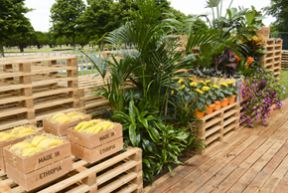Senseless Acts of Beauty
Our Grow Hope journey continues with the third in our trilogy of gardens telling the story of Ethiopia’s recovery from the worst famine in living memory. In this post, our garden award-winning designer John Warland takes us behind the scene at the RHS Hampton Court Palace Flower Show and shares his insights!

Having endured a very wet and wild build-up to the BBC Gardeners World Live show, we were blessed with fine weather for the public to enjoy the garden.
The reaction was amazing as people began to understand the trilogy further and engage with the key messages behind the story. It is not often that an installation moves people to tears due to the power of the message and the emotional resonance created, so I take it as a small compliment that this work did just that.
Seeing all 1000 pots & saplings leave the showground in the care of their new owners was also a great sight. All those hours hand painting them late into the night now seemed worthwhile, and the thought of 1000 new trees gracing the English landscape is an uplifting legacy.
Show-week also held an important date for me – the birthday of my sponsored child Ronald who lives in Bolivia! He was eight years old this month, and sending a card to remind him of our never-ending thoughts and prayers for him and his family was a real joy. It was a true reminder of why telling the story of the Antsokia Valley is so important - so that we can continue to directly impact generations of children across the world.
RHS Hampton Court Palace
The final work has now been created and the trilogy completed at RHS Hampton Court Flower Show, against the magnificent backdrop of Sir Christopher Wren’s baroque façade. The final installation can be briefly summarized by the following quote:
"The single most important object in the global economy."
This quote refers to the humble wooden shipping pallet. It is for this reason that the final in the trilogy of gardens is composed almost entirely from these simple and ubiquitous items.
If you have a thriving local economy and something worthy of export you only need pallets.
After 30 years of development thanks to the work of World Vision, the Antsokia Valley has been transformed from a dustbowl into an oasis. Food production thrives and leaves the valleys on pallets and trucks.
Where aid once fell to earth in crates, it is now exported to neighbouring towns and regions.

The pallets themselves not only represent the physical produce of the valley, but a concept plan for development. This 30 year retrospective allows World Vision to look back on the successes, and export these case studies and development model at regional, national and international level.
This final instalment reminds us that aid is no longer required in the Antsokia Valley and that the large symbolic crate first seen at RHS Chelsea is now a mere skeleton of the initial structure. Inside the crate’s shell stands a mature five metre tall fig tree and coffee beans now cover the soil.
The viewer is invited to step forward and walk through the pallet structure. The native bananas and verdant produce fill & tumble from the crates. The rich utopian landscape first promised in the initial aid drops has now been well and truly delivered.
At the exit of the garden, there are a number of shaded pallet benches to rest upon. Take a moment to contemplate this garden, the trilogy as a whole and the intervening 30 years of development since the first aid crates fell to earth in Ethiopia.
As the visitor leaves the space, the journey is now complete and the message of growing hope in some of the world’s most vulnerable communities is something to look back on and celebrate the successes such as the development in the Antsokia Valley. But more importantly, take the message of growing hope forward and into places where it is required for today, tomorrow and future generational needs.
Thanks to John who was inspired by the 30th anniversary of the Ethiopia famine to help design our World Vision garden. For more information, make sure you check out our Grow Hope campaign.
